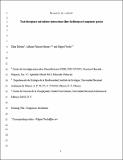Por favor, use este identificador para citar o enlazar a este item:
http://hdl.handle.net/10261/60931COMPARTIR / EXPORTAR:
 SHARE SHARE
 CORE
BASE CORE
BASE
|
|
| Visualizar otros formatos: MARC | Dublin Core | RDF | ORE | MODS | METS | DIDL | DATACITE | |

| Título: | Trait divergence and indirect interactions allow facilitation of congeneric species |
Autor: | Beltrán, Elisa; Valiente-Banuet, Alfonso; Verdú, Miguel CSIC ORCID | Palabras clave: | Associational defences Competition Facilitation Indirect interactions Mycorrhizal networks Phylogenetic relatedness Pollination Seed dispersal Trait divergence |
Fecha de publicación: | nov-2012 | Editor: | Oxford University Press | Citación: | Annals of Botany 110(7): 1369-76 (2012) | Resumen: | Background. Plant facilitation occurs when the presence of a plant (i.e. a nurse plant) modifies the environment, making it more favourable for the establishment and survival of other species (i.e. facilitated plants), which can germinate and grow nearby. Facilitative associations can be maintained or turned into competition as the facilitated seedling grows. According to the competition-relatedness hypothesis that suggests that closely related species tend to compete more, facilitation turns into competition between phylogenetically close species.
However, some examples of facilitation between congeneric species, which are supposed to be closely related species, have been found in nature. Scope. In this work, some examples of congeneric facilitation and subsequent coexistence are reviewed and an attempt is made to explain those exceptions to the competition-relatedness hypothesis. Conclusions. Two mechanisms are proposed that can switch the facilitation–competition balance: trait divergence and indirect interactions. When traits have diverged within the genus, the niche overlap is reduced and competition relaxed, thus allowing the coexistence of congeneric species. The presence of third interplayers (mycorrhizal fungi, seed dispersers, pollinators or pathogens) participating in the interaction between plants can alleviate the competition or enhance the reproduction and allow the coexistence of species that could not coexist in their absence. |
Descripción: | 8 páginas, 1 figura. | Versión del editor: | http://dx.doi.org/10.1093/aob/mcs089 | URI: | http://hdl.handle.net/10261/60931 | DOI: | 10.1093/aob/mcs089 | ISSN: | 0305-7364 | E-ISSN: | 1095-8290 |
| Aparece en las colecciones: | (CIDE) Artículos |
Ficheros en este ítem:
| Fichero | Descripción | Tamaño | Formato | |
|---|---|---|---|---|
| Annals of Botany 110(7).pdf | 707,87 kB | Adobe PDF |  Visualizar/Abrir |
CORE Recommender
PubMed Central
Citations
8
checked on 10-abr-2024
SCOPUSTM
Citations
39
checked on 17-abr-2024
WEB OF SCIENCETM
Citations
38
checked on 24-feb-2024
Page view(s)
351
checked on 24-abr-2024
Download(s)
229
checked on 24-abr-2024
Google ScholarTM
Check
Altmetric
Altmetric
Artículos relacionados:
NOTA: Los ítems de Digital.CSIC están protegidos por copyright, con todos los derechos reservados, a menos que se indique lo contrario.
